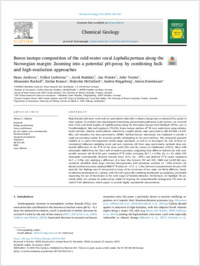Boron isotope composition of the cold-water coral Lophelia pertusa along the Norwegian margin: Zooming into a potential pH-proxy by combining bulk and high-resolution approaches
- Jurikova, Hana GEOMAR Helmholtz Centre for Ocean Research Kiel, Germany
- Liebetrau, Volker GEOMAR Helmholtz Centre for Ocean Research Kiel, Germany
- Raddatz, Jacek Institute of Geosciences, Goethe-University Frankfurt, Frankfurt am Main, Germany
- Fietzke, Jan GEOMAR Helmholtz Centre for Ocean Research Kiel, Germany
- Trotter, Julie School of Earth Sciences and UWA Oceans Institute, The University of Western Australia, Crawley, Australia
- Rocholl, Alexander GFZ German Research Centre for Geosciences – Helmholtz Centre Potsdam, Germany
- Krause, Stefan GEOMAR Helmholtz Centre for Ocean Research Kiel, Germany
- Mc Culloch, Malcolm Oceans Graduate School, UWA Oceans Institute, and ARC Centre of Excellence for Coral Reef Studies, The University of Western Australia, Crawley, Australia
- Rüggeberg, Andres Department of Geosciences, University of Fribourg, Switzerland
- Eisenhauer, Anton GEOMAR Helmholtz Centre for Ocean Research Kiel, Germany
-
20.05.2019
Published in:
- Chemical Geology. - 2019, vol. 513, p. 143–152
English
High-latitude cold-water coral reefs are particularly vulnerable to climate change due to enhanced CO2 uptake in these regions. To evaluate their physiological functioning and potential application as pH archives, we retrieved both recent and fossil samples of Lophelia pertusa along the Norwegian margin from Oslofjord (59°N), over to Trondheimsfjord, Sula and Lopphavet (70.6°N). Boron isotope analyses (δ11B) were undertaken using solution-based and laser ablation multi-collector inductively coupled plasma mass spectrometry (MC-ICP-MS; LA-ICP-MS), and secondary ion mass spectrometry (SIMS). Epi-fluorescence microscopy was employed to provide a rapid pre-screening routine for structure-specific subsampling in the coral skeleton. This integrated approach enabled us to assess heterogeneities within single specimens, as well as to investigate the role of local environmental influences including recent and past variations. All three mass spectrometry methods show substantial differences in the δ11B of the theca wall (TW) and the centres of calcification (COC's). Micro-bulk subsamples milled from the theca wall of modern specimens originating from different habitats but with comparable seawater pH (8–8.16) gave consistent δ11B values averaging 26.7 (±0.2‰, 2σ, n = 4), while COC subsamples systematically deviated towards lower B/Ca (by ~40%) and depleted δ11B values (minimum 22.7 ± 0.3‰, 2σ), implying a difference of at least 4‰ between TW and COC. SIMS and LA-ICP-MS measurements identified much larger internal heterogeneities with maximum variation of ~10‰ between the distinct skeletal structures; minimal SIMS δ11B values of ~17.3 ± 1.2‰ (2σ) were associated with the pure COC material. Our findings may be interpreted in terms of the occurrence of two main, but likely different, biomineralisation mechanisms in L. pertusa, with the COC's generally exhibiting minimal pH up-regulation, potentially supporting the use of bicarbonate in the early stages of biomineralisation. Furthermore, we highlight the potential utility of L. pertusa for palaeo-proxy studies if targeting the compositionally homogenous TW zones devoid of COC admixtures, which appear to provide highly reproducible measurements.
- Faculty
- Faculté des sciences et de médecine
- Department
- Département de Géosciences
- Language
-
- English
- Classification
- Biological sciences
- License
-
License undefined
- Identifiers
-
- RERO DOC 324675
- DOI 10.1016/j.chemgeo.2019.01.005
- Persistent URL
- https://folia.unifr.ch/unifr/documents/307774
Statistics
Document views: 140
File downloads:
- pdf: 202
